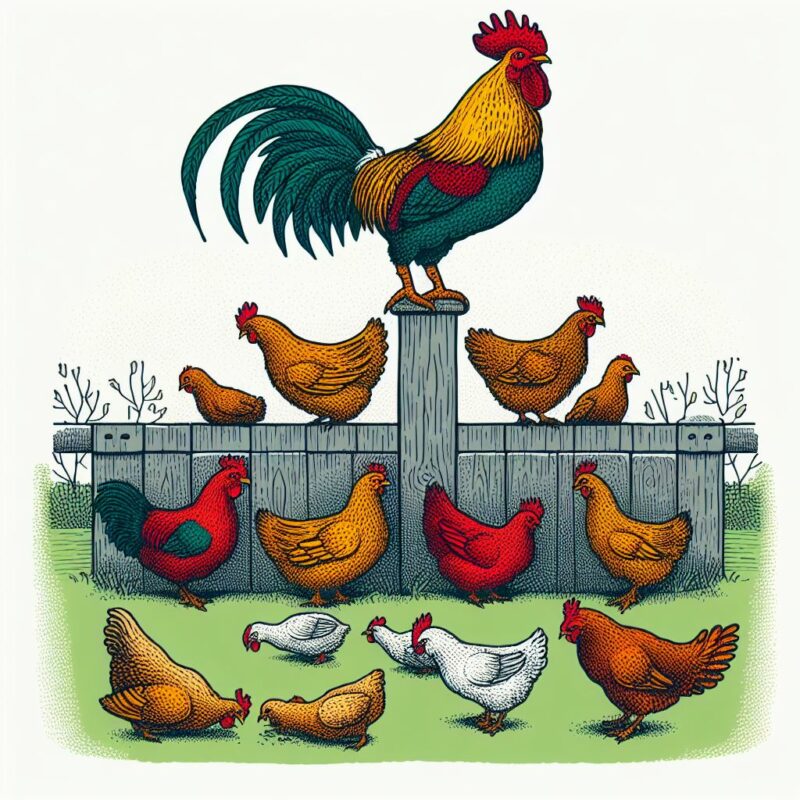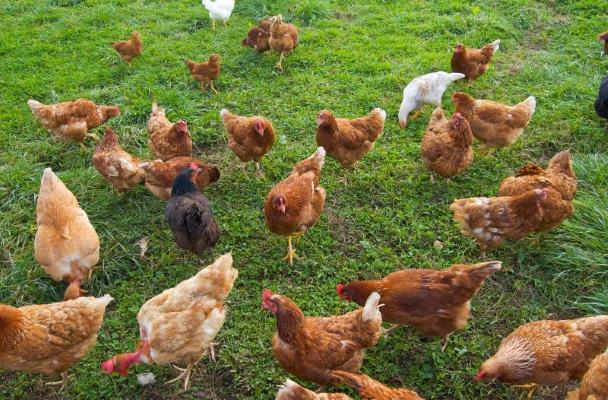
Unveiling the World of Chickens’ Social Behavior
Hey Folks!
Today, we will jump into chickens’ social dynamics with a look at the ” chicken pecking order behavior” — a term that’s not just for the birds!
If you’ve ever watched your backyard flock for a while, you’ll notice there’s a whole soap opera unfolding right in the coop. Understanding the pecking order is crucial for anyone looking to raise a happy, healthy flock.
So, what’s this all about? Well, chickens aren’t just wandering around aimlessly; they have a complex social structure that determines who gets first dibs on food, the best roosting spots, and even the pecking rights.
This hierarchy is established early on and can influence everything from feeding to nesting.
In this article, we’re going to reveal the pecking order from the top roost to the bottom rung.
We’ll find out how it forms, why it’s important for the well-being of your chickens, and what changes you might expect as your flock grows and dynamics shift.
Whether you’ve been keeping chickens for a long time or just starting out with your first few chicks, getting to grips with this behavior is key to maintaining peace in the coop.
So, let’s get to it and unravel the mysteries of chicken pecking order behavior, shall we?
Pecking Order Explained: Chicken’s Social Hierarchy and Order
In the business of chickens, the pecking order is the equivalent of a corporate ladder. It’s an invisible hierarchy that dictates the social standing of each chicken in the flock.
This isn’t just about who struts around with the most swagger; it’s a well-organized system that determines who eats first, who gets the best spots to roost, and even who gets to drink water without interruption.
It’s like a set of unwritten rules that every chicken must learn and instinctively accept from the moment they fluff their first feathers to their last breath.
Pecking order is quite complex from a distance. It’s not just about hens and roosters. Pecking order rules have to be established between hens and hens, roosters and roosters, roosters and hens, adults and young ones, and poults and poults. Whew!
Factors Determining a Chicken’s Place in the Pecking Order
Several factors come into play when chickens establish their pecking order. It’s not just about size or strength; it’s a complex mix. Here are a few:
- Age and Seniority: Older chickens tend to hold higher ranks. Experience matters in the coop, and the elder hens (or roosters) often command respect.
- Personality and Temperament: Bold and assertive chickens often climb higher on the pecking order, while the more timid ones might find themselves lower down.
- Physical Strength and Health: A robust chicken is more likely to be an alpha, leading the flock and taking charge during feeding time.
- Resourcefulness: Chickens that find the best food sources or the coziest nesting spots can earn a higher rank.
- Breed Characteristics: Some breeds are naturally more dominant, which can influence their standing within the group.
Generally speaking, the hierarchy goes roosters, hens, cockerels, then pullets.
Cockerals eventually become cocks, and pullets will jockey for position as they mature.
New birds added to the flock will find their station in short order, and it will not necessarily be at the bottom of the flock.
The Impact of Pecking Order on Chicken Behavior and Flock Harmony

The pecking order is not just about establishing who’s the boss; it’s a critical element for flock harmony.
Chickens thrive on stability, and the pecking order provides a structured environment where each bird knows its place.
This social structure reduces conflicts because each chicken understands the hierarchy and generally doesn’t challenge it without cause.
However, it’s not all peace and quiet. Sometimes, you’ll see squabbles and feather ruffling as new contenders rise or when integrating new birds into an established flock. But once the pecking order is settled, it brings a sense of order and peace to the coop.
Chickens lower in the hierarchy may not get the first pick of the treats, but they’ll live a relatively stress-free life without the burden of leadership.
Understanding and managing the pecking order is essential. It’s not about playing favorites; it’s about ensuring that every chicken gets its fair share of resources and respect.
By keeping a close eye on the flock dynamics, you can intervene when necessary to keep the peace and ensure that every member of your backyard brood feels like they’re part of the pecking order, not just pecked on.
The Establishment of a Pecking Order: When does it Begin and How Long does it Last?
Pecking order behavior can start as early as when chicks are still in the brooder, mere weeks after hatching.
Even at this tender age, they begin to test the waters of social hierarchy through playful pecks and mini scuffles. It’s a bit like the chicken version of a schoolyard, where the youngsters learn the ropes of social conduct.
As they feather out and grow, these interactions become more pronounced, setting the stage for the more structured pecking order of adult life.
Understanding the Timeline of Pecking Order Establishment

The timeline for establishing a pecking order can vary, but it typically takes a few weeks for the dust to settle and the order to solidify. During this time, you’ll notice more jostling for position, assertive posturing, and the occasional squabble.
It’s a natural process as each chicken vies for its spot in the social pecking order. Once the hierarchy is established, it doesn’t often change unless new birds are introduced or the existing balance is disrupted in some way.
Variables Affecting the Duration of Pecking Order Establishment
Several variables can affect how quickly and smoothly the pecking order is established:
- Flock Size: In larger flocks, it can take longer for chickens to sort themselves out simply because there are more birds to interact with and more relationships to establish.
- Space: Limited space can increase tension and competition, leading to a more prolonged and possibly more aggressive pecking order establishment process.
- Age and Size Diversity: A flock with a wide range of ages and sizes may take longer to establish a pecking order as the dynamics are more complex.
- Breed: Some breeds are more assertive or aggressive and may establish a pecking order more quickly, while more docile breeds might take a more laid-back approach.
- Resources: The abundance or scarcity of resources such as food, water, and nesting spaces can significantly impact how chickens interact and establish hierarchy.
- Introductions and Departures: Adding new members to the flock or losing some can cause a reevaluation of the pecking order, extending the time it takes for the new social structure to stabilize.
Understanding these variables can help you manage your flock more effectively. By providing ample space, equal access to resources, and careful integration of new birds, you can foster a more harmonious environment that supports a quicker and less stressful pecking order establishment.
Life within the Hierarchy: What Happens Once the Pecking Order is Established?
Once the dust settles and the pecking order is firmly established, the impact on the flock is like night and day. A clear hierarchy reduces skirmishes over food, water, and nesting spots because each chicken knows its place and the consequences of stepping out of line.
This doesn’t just make for a calmer coop; it also promotes better health among the flock since stress is significantly reduced, and stress, as any seasoned chicken keeper knows, can lead to a whole coop full of trouble.
Behavior of Chickens at Various Levels of the Pecking Order
At the top of the pecking order, you’ve got the alpha chicken. This bird struts with confidence, eats first, and chooses the best spots for everything from dust baths to roosting. They’re the ones keeping order, and the rest of the flock often looks to them for cues.
In the middle, you’ve got the majority of your flock. These birds live a relatively peaceful existence, following the leader and maintaining the status quo. They wait their turn and generally don’t cause a ruckus unless there’s a shift in the hierarchy.
At the bottom are the subordinates, often the last to eat and sometimes the targets of pecking by higher-ranked chickens.
While this might seem harsh, these birds still play a role in the flock and can live contentedly as long as their basic needs are met without too much hassle from their coop-mates.
The Stability of a Chicken Flock Once the Pecking Order is Set
A chicken flock with a well-established pecking order is like a well-oiled machine.
Each bird plays its part, and daily life runs smoothly. There’s less fighting, less stress, and more time for the important things—like laying eggs and enjoying a good dust bath.
Of course, the occasional challenge to the hierarchy can occur, usually when a new bird is introduced or an existing bird grows stronger or weaker. But generally, a settled pecking order means a stable and happy flock.
It’s important to note that while the pecking order brings stability, it doesn’t mean the keeper’s job is done.
Regular observation is key to ensuring that no chicken is being bullied to the point of harm and that even those at the bottom are getting their fair share of the coop’s resources.
In the end, a stable pecking order is beneficial not just for the chickens but for you as well. It means less intervention is required, fewer injuries to treat, and more time to enjoy the simple pleasure of watching your flock engage in their natural behaviors.
How to Help Reduce Pecking Order Stress
Common sense, it is said, is not always so common, so forgive me if some of these stress-reducing methods seem simplistic.
In order to keep pecking order stress from turning into a brawl, these suggestions will help:
- Allow enough room in living areas for chickens to get away from each other if needed.
- Make certain that chickens have enough food and fresh water.
- Provide distractions such as toys, tunnels, hay bales, etc., to keep chickens apart.
- Try to keep roosters apart as much as possible by providing each one you have with their own feeding and watering station.
- Avoid adding new chickens to your flock. When doing so, try to do so gradually. Keep coops on the dark side to keep chickens calm.
- Culling weak birds is not a good solution since there will always be
Deciphering Chickens’ Social Dynamics for Optimal Flock Management
As we’ve ruffled through the ins and outs of chicken hierarchy, it’s clear that the pecking order is more than just a quirky aspect of chicken behavior—it’s a fundamental part of their existence that shapes their daily lives.
Understanding the pecking order is crucial for anyone looking to keep a flock that’s not just surviving but thriving.
By recognizing the signs and subtleties of this social structure, we, as chicken owners, can manage our flocks with a more informed, compassionate approach.
We can prevent bullying, ensure that even the lowest-ranking members of the flock get their needs met, and intervene when the pecking order causes undue stress or harm.
Moreover, our knowledge of the pecking order isn’t just about keeping the peace; it’s about appreciating the complex social behaviors of these fascinating creatures.
Continued research and observation can reveal even more about how chickens interact, bond, and establish their communities, enriching our understanding and our ability to care for them.
In conclusion, the pecking order is a vital piece of the chicken-keeping puzzle. By understanding it, we’re not just better poultry keepers; we’re also witnesses to the intricate social tapestry that is the life of chickens.
So, let’s keep our eyes open, our minds curious, and our hearts full of respect for the feathered friends who bring so much joy (and eggs!) into our lives.
Here’s to the pecking order, to every chicken in the flock, and to the keepers who watch over them.
Thank you.
Dave
Chickenmethod.com
